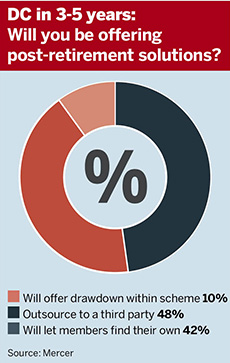One in 10 UK employers have said they will offer members post-retirement drawdown facilities within their defined contribution scheme in three to five years, according to a poll, but advisers still doubt trustees’ desire to govern such provision.
 The survey findings, published this week by consultancy Mercer, emerge amid the backdrop of the new pension freedoms announced in this year’s Budget, which will see members ‘guided’ towards an array of possible retirement options including taking the cash as a lump sum, drawdown and annuitisation.
The survey findings, published this week by consultancy Mercer, emerge amid the backdrop of the new pension freedoms announced in this year’s Budget, which will see members ‘guided’ towards an array of possible retirement options including taking the cash as a lump sum, drawdown and annuitisation.
Mercer polled 300 UK employers and trustees on whether they would be likely to offer post-retirement facilities to their members. Ten per cent said they would offer drawdown within the scheme, 48 per cent would outsource to a third party, while the remainder (42 per cent) said they would leave members to make their own arrangements.
Brian Henderson, UK DC and savings leader at Mercer, said members will most likely be guided towards “well-governed” plans such as mastertrusts or other provider arrangements where fees have been pre-negotiated, with responsibility moving away from the trustees to the third party.
“Saying that, I could imagine hybrid structures being developed, where trustees or companies retain some ability to challenge and steer post-retirement outsourced solutions,” he added, “perhaps within a mastertrust, in a similar way to those already in existence pre-retirement.”
But Mark Futcher, head of DC at Barnett Waddingham, said trustees would not want to govern the stage at which members decide to access their pension savings and would most likely outsource to a third party.
He added: “I can see trustees maybe having a mirror policy but structured as a contract-based arrangement or contract-based Sipp [self-invested personal pension]. So it mirrors the kind of trust but they say [to the member], ‘As soon you’ve decided to access this, you’re out into a personal policy’.”
In June, the £2.2bn JPMorgan UK Pension Plan outlined its intention to introduce a drawdown option. The plan had already modified its default strategy ahead of the new freedoms to enable greater flexibility for members.
Under the current default strategy members are contacted around five years ahead of their retirement date and are given two additional alternatives to annuitisation: they can either remain fully invested in a blend of diversified growth funds to, and potentially through, retirement; or for those wanting to take the 25 per cent tax-free lump sum, they can remain invested in the DGFs until 18 months before retirement at which point 25 per cent of their pot is converted to cash.
The scheme is still in discussions with a provider but intends to have further modified its post-retirement capabilities by the end of 2015.
I could imagine hybrid structures being developed, where trustees or companies retain some ability to challenge and steer post-retirement outsourced solutions
Brian Henderson, Mercer
Martin Freeman, director at JLT Employee Benefits, said schemes need to act quickly to establish their position ahead of April next year when the reform is implemented. Which way they go will depend on their membership profile and the employer’s strategy for managing older workers, he said.
“Schemes where most members have smaller pots will see most of their retirees taking trivial commutation or cashing out in the near future,” Freeman said.
“Employers need to decide whether or not they want to support older workers gradually winding down their employment and supplementing their income from their retirement pot. If they do, they will need to ensure their pensions schemes meet that need.”
The Mercer poll also found that 62 per cent of respondents plan to offer additional support to members at retirement, in addition to signposting the guidance guarantee.
And on members exercising their freedom to transfer from defined benefit to DC, 76 per cent of survey respondents said they expected fewer than 20 per cent to transfer, 16 per cent expected more than 41 per cent of members to transfer to DC, and 8 per cent anticipate 21-40 per cent to transfer.
An earlier version of this article mistakenly said the JPMorgan scheme planned to allow members to remain fully invested in DGFs until 18 months before retirement, at which point they could convert 95 per cent of their pot into cash or remain invested. This was corrected online a day after publication.














